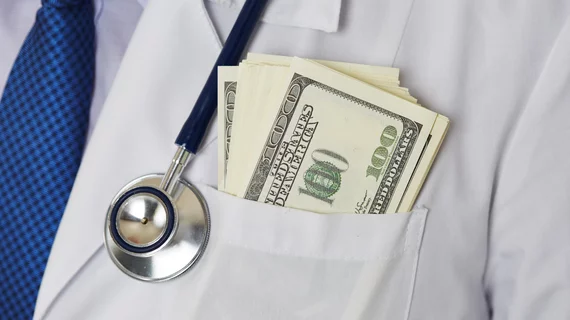Radiologists collected more than $370 million in gifts, speaking fees and other perks unrelated to their regular reading duties. However, the money appears to be concentrated among a select few physicians at the top 5%.
Members of the specialty received more than 513,000 such “industry payments” during the five years ending with 2020. About 7 of 10 radiologists in the U.S. collected at least one such check, for a median amount of $27, experts wrote. Academic Radiology published their study May 18 [1].
Concentrating only on the top 5% of earners, however, shifts the numbers and conversation. More than 91% of the total pot of money (or $338 million) went to this smaller group of radiologists. They received a median payment value of almost $59,000 across five years (or just shy of $12,000 annually). That’s compared to $172 over five years (or $34 annually) among the bottom 95%.
“It remains unclear what impact these concentrated payments have on physicians’ decision-making and whether different types of payments have different effects, which will need to be examined in future studies,” Ajay Malhotra, MD, with the Yale School of Medicine, and co-authors wrote. “Lack of correlation between the categories, especially research and consulting/royalty and speaker fees, is concerning. The low proportion of industry payments toward research also needs to be addressed, especially given the technology-intensive nature of the field.”
Researchers gathered information from CMS’s Open Payments Database, created to shine light on physicians’ relationships with vendors and other entities. The sample spanned full calendar years from 2016 through 2020 and included six payment categories: consulting fees, education, gifts, research fees and royalties/ownership in industry entities. The investigators included both diagnostic and interventional radiologists, along with radiation oncologists.
Gifts—from entities such as professional medical associations, pharmaceutical companies, biotechnology firms or medical device manufacturers—were the most frequent type of payment at 76% (391,963/513,020). However, these only accounted for about 5% of the total pot, or $17.8 million. Meanwhile, royalty/ownership payments accounted for 0.2% of payments (1,153) but constituted the highest value at more than $118.5 million or 32% of the total. Just 179 radiologists collected these payments, worth a median value of $6,042.
Other high dollar-figure industry payments included:
- Consulting fees totaled $107.9 million or 29% of the pot on 33,590 payments (6.5%).
- Speaker fees totaled $88.3 million (24% of the total) on 7,110 payments (25%)
- Research represented 9% of the total or $33.5 million, spread across 6,553 payments (1%).
- Education payments totaled nearly $4.7 million (1% of the pot) across 4,552 payments (0.9%).
Concentration among the top 5% of radiologists is not unique to the specialty, Malhotra and co-authors noted. Across all physician types, 91% of such industry payments also went to the top 5%. In radiology, the variation can be explained by the concentration in number and value of payments.
Among the top 5%, the proportion of rads receiving payments was higher across all categories (except for gifts) when compared to the other 95%. For instance, 73.5% of radiologists in the 95th percentile received payments for consulting work, compared to 5.6% among the rest. Median value of payments also was higher across all categories for the top 5% ($1,927) versus the bottom 95% ($65).
Royalty/ownership (typically, payments based on the sale of a radiologists’ intellectual property) were the biggest moneymaker, earning the top 5% $75.1 million. The top 5% also received a significant portion of their payments from speaker fees (27.9%) and consulting fees (18%). That’s compared to the bottom 95%, which only collected about 8% of payments from speaker fees.
“There is value in the academic-industry relationship for both parties with potential for technology transfer and the opportunity to receive sponsorship to drive research,” the authors commented. “The fact that the largest category of payments by value to the top 5% was royalties/ownership (and the second largest category was consulting) suggests the latter point about innovation rather than quid pro quo relationships. This is further evinced by the smaller share of gifts, both by value and by number, among the top 5%. The correlation between concentration of payments and potential ethical concerns needs further study.”
Radiology researchers published a similar study on industry payments in the Journal of the American College of Radiology earlier this month.

